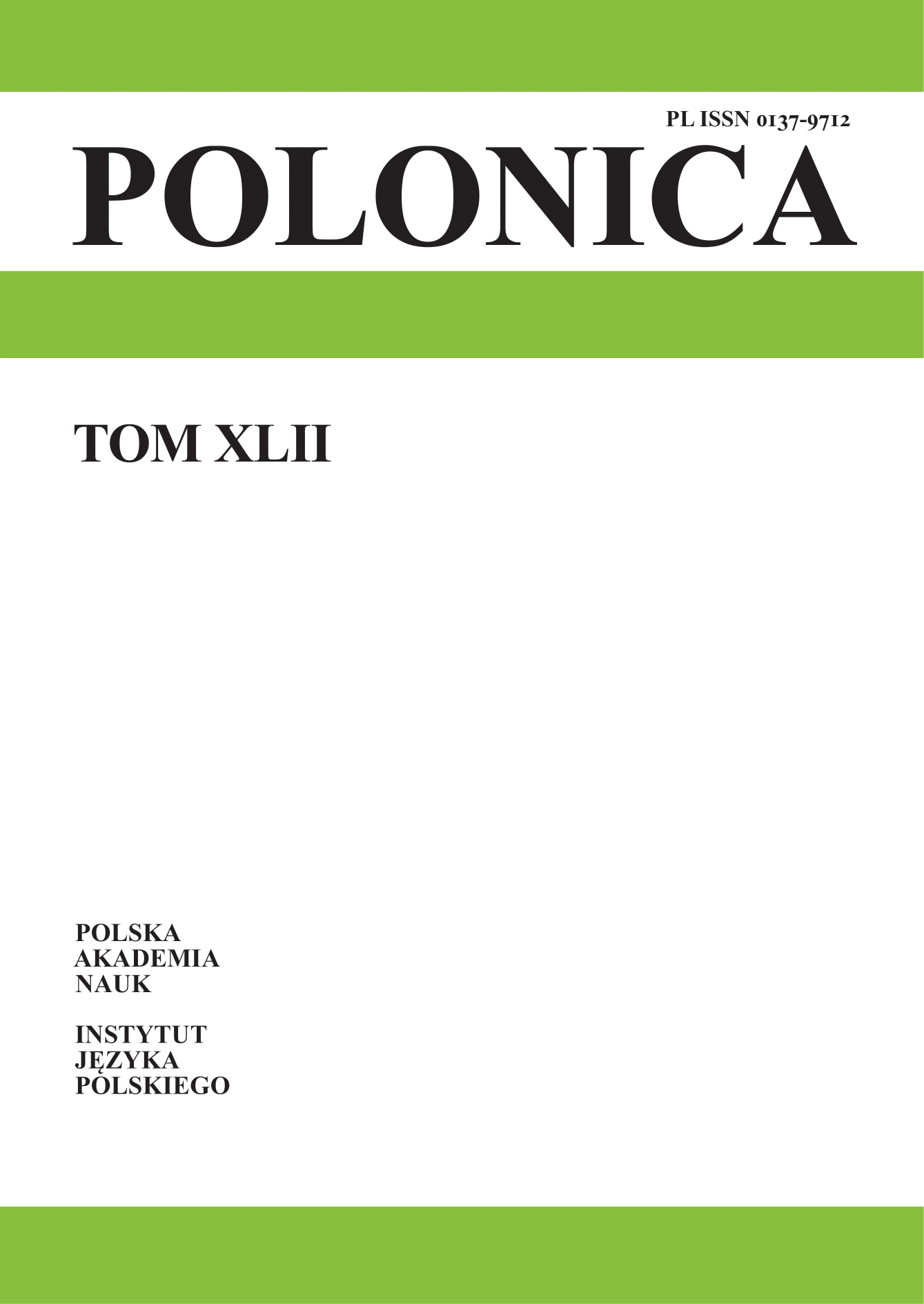Abstract
Intertextuality focuses on the relationship between different texts, either spoken or written. These connections have been the subject of research for many scholars around the world and initially were discussed mainly from the point of view of literary theory (Tomaszkiewicz, 2006, p. 175). The aim of this paper is to examine intertextual references in the context of translation theory, taking into account the various techniques and strategies employed when translating direct or indirect references in a dubbing format. The author analyses dialogues from the DreamWorks production “Shrek” (2001), the Disney films “Zootopia” (2016) and “Wreck-It-Ralph” (2012), as well as the Pixar Animation Studios film “Toy Story 3” (2010) with the aim of identifying intertextual references in the source text and comparing them with their Polish and German translations. The author also considers the sources of intertextuality in animation films and the translator’s role in decontextualizing this genre in the target language, drawing attention to the issue of discourse and the agency of audiovisual translators.
References
Adamzik, K. (2001). Sprache: Wege zum Verstehen. Tübingen: A. Francke Verlag.
Alshehri, F. (2020). Zur Synchronisation von Humor – Eine Fallstudie. Diyalog Interkulturelle Zeitschrift für Germanistik, 1, 194–209.
Borodo, M. (2017). Translation, globalization and younger audiences. The situation in Poland. Oxford: Peter Lang.
Chaume, F. (2007). Quality standards in dubbing: Aproposal. Tradterm, 13, 71–89.
Chaume, F. (2012). Audiovisual translation: dubbing. Manchester: St. Jerome.
Chmiel, A. (2010). Translating postmodern networks of cultural associations in the Polish dubbed version of Shrek. In Diaz Cintas J., Matamala A. & Neves J. (Eds.), New Insights into Audiovisual Translation and Media Accessibility. Media for All, 2 (123–136). Amsterdam–New York: Brill.
De Rosa, G., Bianchi, F., De Laurentiis A. & Perego, E. (2014). Translating Humour in Audiovisual Texts. Bern: Peter Lang.
Döring, S. (2006). Kulturspezifika im Film: Probleme ihrer Translation. Berlin: Frank Timme.
Farahzad, F. (2009). Translation as an intertextual practice. Perspectives: Studies in Translatology, 16(3–4), 125–131.
Federici, E. (2007). The translator’s intertextual baggage. Forum for modern language studies, 43(2), 147–160.
Fix, U. (2009). Aspekty intertekstualności. In Bilut-Homplewicz Z., Czachur W., & Smykała M. (red.), Lingwistyka tekstu w Niemczech. Pojęcia, problemy, perspektywy (196–210). Wrocław: ATUT.
Gray, J. (2006). Watching with the Simpsons. Television, parody, and intertextuality. Abington: Routledge.
Hejwowski, K. (2012). Kognitywno-komunikacyjna teoria przekładu. Warszawa: PWN.
Heydel, M. (1995). Jak tłumaczyć intertekstualność. Między Oryginałem a Przekładem, 1, 21–33.
Janikowski, P. (2004). Dobry polski Szrek. Wrażliwość kulturowa tłumacza w rękach magnatów popkultury. In Fast P. (Ed.). Kultura popularna a przekład (39–47). Katowice: Śląsk.
Jankowska, A. (2009). Translating Humor in Dubbing and Subtitling. Translation Journal, 13(2). https://translationjournal.net/journal/48humor.htm
Jüngst, H. (2020). Audiovisuelles Übersetzen. Ein Lehr-und Arbeitsbuch. Tübingen: Narr Verlag.
Kalıpcı, M. (2018). Subtitling allusions from English to Turkish: Study of ‘the Simpsons’. Journal of Language and Linguistic Studies, 14(1), 342–358.
Klimovich, N. (2014). Phenomenon of intertextuality in translation studies. Humanities & Social Sciences, 2, 255–264.
Kristeva, J. (1972). Problemy strukturowania tekstu, transl. W. Krzemień. Pamiętnik, 63(4), 233–250.
Leppihalme, R. (1997). Culture Bumps. An empirical approach to the translation of allusions. Clevedon: Multilingual Matters.
Leszczyńska, U., & Szarkowska, A. (2018). “I don’t understand, but it makes me laugh.” Domestication in contemporary Polish dubbing. The Journal of Specialised Translation, 30, 203–231.
López González, R.C. (2015). Dubbing intertextuality in Dreamworks animated films. In Bogucki, Ł., & Deckert, M. (Eds.), Accessing audiovisual translation (11–26). Oxford: Peter Lang.
López González, R.C. (2017). Humorous elements and translation in animated feature films DreamWorks (2001–2012). MonTI, 9, 279–305.
López González, R.C. (2018). The art of including art in animation: DreamWorks’ intertextual games for all. Journal of Literary Education, 1, 107–129.
Martinez-Sierra, J.J. (2010). Building bridges between cultural studies and translation studies: with reference to the audiovisual field. Journal of Language & Translation, 11(1), 115–136.
Metz, M., & Seeßlen, G. (2009). Das Kino spricht deutsch. Glanz und Elend der Synchronisation. https://www.deutschlandfunkkultur.de/das-kino-spricht-deutsch.984.de.html?dram:article_id=153454
Muszyńska, A. (2011). Intertekstualność jako forma dialogu kulturowego. Przekłady Literatur Słowiańskich, 2(1), 295–305.
Nedergaard-Larsen, B. (2010). Culture-bound problems in subtitling. Perspectives: Studies in Translatology, 1(2), 207–240.
Nycz, R. (1990). Intertekstualność i jej zakresy: teksty, gatunki, światy. Pamiętnik Literacki: czasopismo kwartalne poświęcone historii i krytyce literatury polskiej, 81(2), 95–116.
Pérez-Simón, A. (2019). Intertextuality and antonomous fictional worlds in Disney: the case of Moana (2016). Theatralia, 22(2), 72–82.
Ramière, N. (2006). Reaching a foreign audience: cultural transfers in audiovisual translation. The Journal of Specialised Translation, 6, 152–166.
Sager, S. (1997). Intertextualität und die Interaktivität von Hypertexten. In Klein, J., & Fix, U. (Eds.), Textbeziehungen. Linguistische und literaturwissenschaftliche Beiträge zur Intertextualität (109–123). Tübingen: Stauffenburg.
Schmitz, U. (2016). Multimodale Texttypologie. In Klug N., & Stöckl H. (Eds.), Handbuch Sprache im multimodalen Kontext (327–347). Berlin–Boston: De Gruyter.
Sikora, I. (2013). Dubbing filmów animowanych. Nysa: Oficyna Wydawnicza PWSZ.
Summers, S. (2020). DreamWorks animation. London–New York: Palgrave Macmillan.
Tomaszkiewicz, T. (2006). Przekład audiowizualny. Warszawa: PWN.
Urbanek, D. (2010). Translatoryczna myśl postmodernistyczna: intertekstualny model przekładu. Lingwistyka Stosowana, 2, 195–201.
Venuti, L. (1995). The Translator’s Invisibility: A history of translation. London/New York: Routledge.
Venuti, L. (2009). Translation, Intertextuality, Interpretation. Romance Studies, 27(3), 157–173.
Sources
Adamson, A., & Jenson, V. (2001). Shrek. DreamWorks Pictures.
Howards, B., & Moore, R. (2016). Zootopia. Walt Disney Studios Motion Pictures.
Moore, R. (2012). Wreck-It-Ralph. Walt Disney Studios Motion Pictures.
Shrek. The Internet Movie Script Database. https://imsdb.com/scripts/Shrek.html (accessed: 23.03.2022).
Toy Story 3. Script Slug. https://www.scriptslug.com/script/toy-story-3-2010 (accessed: 23.03.2022).
Unkrich, L., (2010). Toy Story 3. Walt Disney Studios Motion Pictures.
Wreck-It-Ralph. Subtitles Like Scripts. https://subslikescript.com/movie/Wreck-It_Ralph-1772341 (accessed: 23.03.2022).
Zootopia. Subtitles Like Scripts. https://subslikescript.com/movie/Zootopia-2948356 (accessed: 23.03.2022).

